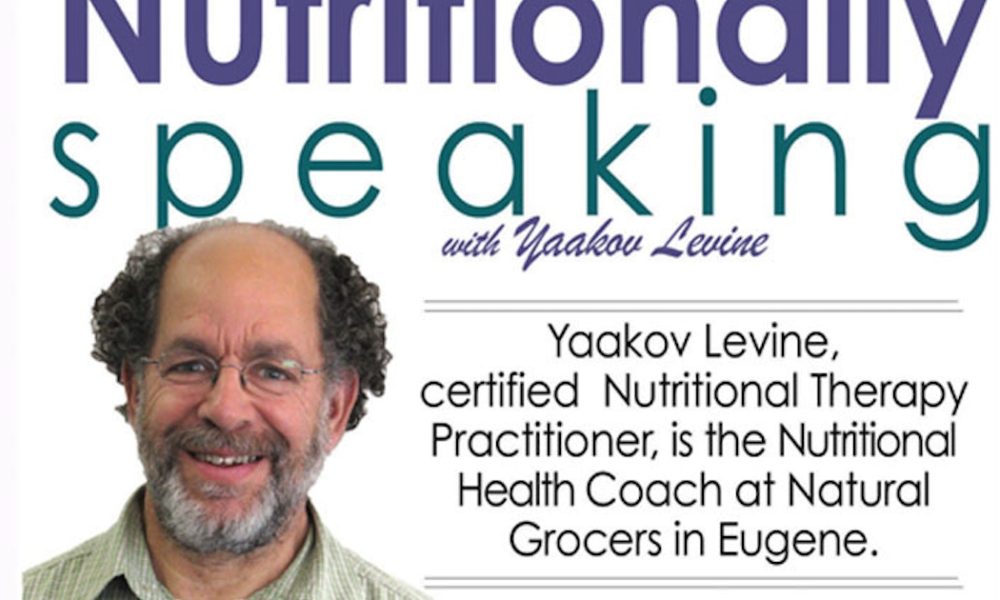
As many of you know I teach (free) health classes and cooking demonstrations as part of my role as Nutritional Health Coach at Natural Grocers. There is a common thread in all of our classes, and that is an important concept we promote: The importance of nutrient density in our food choices. Simply put, a nutrient dense meal or snack will include an abundant amount of important nutrients, and not just empty calories.
In class we teach about the importance of vegetables, and we suggest every meals’ plate be half filled with vegetables. One of the books I use as a resource and is often part of my class displays is ”Eating on the Wild Side – The Missing Link to Optimal Health” by Jo Robinson.
As we learn from the author’s more than 10 years of research, there are many reasons why a particular fruit or vegetable is nutritious. Among the variables are: the color, when harvested, how many miles and days to market, along with how we store and prepare the produce. As we plan our gardens for next summer, the author’s insights offer us an opportunity to reap more of the nutritional benefits of the food we grow.
Robinson offers useful and sometimes surprising tips throughout the book, for example:
”Slicing, chopping, or pressing garlic and letting it rest for ten minutes before cooking, boosts its ability to fight cancer and cardiovascular disease.”
I have been following this suggestion since reading this book, and this may be a reason behind my improved blood pressure levels.
Cooked carrots have twice as much beta-carotene as raw carrots. Have you ever noticed my carrots taste better prepared this way?
Tearing romaine lettuce the day before you eat it doubles it’s antioxidant value. One way you can enjoy romaine is as a lettuce wrap, either in place of a tortilla or a burger bun.
Red cherry tomatoes have up to twelve times more lycopene than red beefsteak tomatoes.
Ounce per ounce, there is more fiber in raspberries than in bran cereals.”
The books Introduction, titled ”Wild Nutrients Lost and Found,” begins with an important question: ”Where do our fruits and vegetables come from?” Not from the supermarket, Robinson answers, ”that’s just where they are sold.” She also suggests that these foods also do not come from the large commercial farms, local farms or even our back yard gardens! That’s just where they are planted and harvested.
Where the fruits and vegetables really come from is a major premise of this book. Robinson offers that our food comes from the wild plants that grow in various areas around the world. She notes for example that most of our blueberries ”are descended from wild swamp blueberries that are native to the Pine Barrens of New Jersey.” In each chapter, the author shares historical, cultural, culinary and nutritional information about our original and more nutrient dense fruits and vegetables.
There are many charts and graphs interspersed throughout the book to illuminate the nutrition differences of the various species, and the nutritional density we have lost in the 10 thousand years we have been farming. She offers that, ”Growing food on mega-farms greatly increased productivity, but it caused a marked loss of flavor. Fruits and vegetables now spend days and weeks in transport and storage, which used up their phyto-nutrients and natural sugars and made them more acidic and bitter.”
Each of her 17 chapters, split into parts one and two, vegetables and fruit, respectively, has an introduction to the agricultural and culinary history to the individual item, what are the nutritional values, how to prepare, store, grow and how to shop for the most nutritious specimens of each species. Let’s explore highlights of some of her chapters for a taste of what these pages offer.
Chapter 1, with its title: ”From Wild Greens to Iceberg Lettuce” explores the wild greens we ate as hunter gatherers along with the many lettuces, and the many greens such as arugula and spinach we enjoy today. Speaking of spinach, (as well as many other vegetables described throughout the book) it is critically important how we prepare them if we want to get any nutritional benefit. If you boil spinach three-quarters of the leaves’ antioxidant rich phytonutrients and antioxidants will be lost in the water. She suggests steaming spinach for more nutritional benefit.
She begins her chapter on alliums: onions, garlic, shallots, leeks and scallions, with Hippocrates famous quote, ”Let food be thy medicine and medicine be thy food.” Robinson is a seasoned writer with a sense of humor. In her section about garlic, she describes the beneficial ”anti” properties of garlic; due in large part to a phyto-nutrient present called allicin. These include, antioxidant, antibacterial, antiviral, anti-clotting and anticancer. Because of all of these benefits she has dubbed garlic as the ”Allicin in Wonderland Drug.” She also suggests that our love for sweeter and milder onions may make us more vulnerable to disease.
The sub-title of her chapter about blueberries, blackberries and other berries is ”Extraordinarily Nutritious.” One of our most nutritious berries is the chokeberry, also known as aronia berry. In a chart comparing the nutritional value of our popular cultivated blueberry varieties and aronia berry, it is clear that the aronia is a superior choice for antioxidant value. The blueberries, while lower in nutritional value compared to aronia, are still ”nutritional superstars,” and have as much as four times the antioxidant activity of other fruit, ten times more than most vegetables and a whopping 40 times more antioxidant value than cereals!
This is a book for everyone who wants to get the most nutrition from their produce. It is available for purchase at Natural Grocers and should be available at your local library. The depth of the author’s research and wealth of knowledge shared is evident in the first few pages, and her gift for writing makes this an informative and enjoyable guide. Salud!







